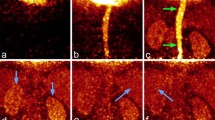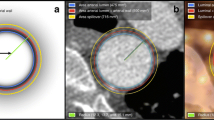Abstract
Objective
Positron emission tomography (PET) angiography is a promising PET imaging method for vessel evaluation. With advances in PET technologies, PET angiography of the whole body is now possible using continuous bed motion (CBM) mode. This study aimed to evaluate the image quality for depicting the aorta and main branches and the diagnostic performance of whole-body PET angiography in patients with vascular disease.
Methods
We retrospectively identified 12 consecutive patients who underwent whole-body 2-deoxy-2-[18F]fluoro-d-glucose ([18F]FDG) PET angiography in CBM mode. Whole-body PET angiography was performed between 20 and 45 s after administering [18F]FDG using CBM from the neck to the pelvis. The visibility of whole-body PET angiography was assessed for the 24 segments in three regions per patient using a 4-point grading scale (1, unacceptable; 2, poor; 3, good; 4, excellent), and grades 3 and 4 were considered diagnostic. The diagnostic accuracy of whole-body PET angiography for detecting vascular abnormalities was calculated using contrast-enhanced CT as a reference standard.
Results
We evaluated 285 segments from 12 patients, and overall, 170/285 segments (60%) were considered diagnostic throughout the whole body, including 96/117 (82%), 22/72 (31%), and 52/96 (54%) segments in the neck-to-chest region, abdominal region, and pelvic region, respectively. The sensitivity, specificity, and accuracy of whole-body PET angiography for detecting vascular abnormalities were 75.9%, 98.8%, and 96.5%, respectively.
Conclusions
Whole-body PET angiography showed a better image quality for the neck-to-chest and pelvic regions in this setting, although it provided limited information on the vessels in the abdominal region.





Similar content being viewed by others
Abbreviations
- 3D:
-
Three-dimensional
- CBM:
-
Continuous bed motion
- CTA:
-
Computed tomography angiography
- [18F]FDG:
-
2-Deoxy-2-[18F]fluoro-d-glucose
- [18F]FEC:
-
[18F]fluoroethylcholine
- GCA:
-
Giant cell arteritis
- MRA:
-
Magnetic resonance angiography
- PET:
-
Positron emission tomography
- RNA:
-
Radionuclide angiography
- TAK:
-
Takayasu arteritis
References
Miyamae T, Fujioka M, Tsubogo Y, Tonariya Y, Dohi Y, Akashi Y, et al. Detection of a large arteriovenous fistula between the internal Iliac vessels by radionuclide angiography. J Nucl Med. 1979;20:36–8.
Garty I, Siplovich L, Horowitz J, Miron D, Verstandig A, Dharan M. Radionuclide blood pool scintigraphy in a child with intestinal arteriovenous malformation (juvenile angiodysplasia). A case report and review of the literature. Eur J Nucl Med. 1991;18:992–5. https://doi.org/10.1007/BF00180422.
Katayama H, Yamaguchi K, Kozuka T, Takashima T, Seez P, Matsuura K. Adverse reactions to ionic and nonionic contrast media. A report from the Japanese Committee on the Safety of Contrast Media. Radiology. 1990;175:621–8. https://doi.org/10.1148/radiology.175.3.2343107.
van der Molen AJ, Reimer P, Dekkers IA, Bongartz G, Bellin MF, Bertolotto M, et al. Post-contrast acute kidney injury—part 1: definition, clinical features, incidence, role of contrast medium and risk factors: recommendations for updated ESUR Contrast Medium Safety Committee guidelines. Eur Radiol. 2018;28:2845–55. https://doi.org/10.1007/s00330-017-5246-5.
Bernstine H, Braun M, Yefremov N, Lamash Y, Carmi R, Stern D, et al. FDG PET/CT early dynamic blood flow and late standardized uptake value determination in hepatocellular carcinoma. Radiology. 2011;260:503–10. https://doi.org/10.1148/radiol.11102350.
Schierz JH, Opfermann T, Steenbeck J, Lopatta E, Settmacher U, Stallmach A, et al. Early dynamic 18F-FDG PET to detect hyperperfusion in hepatocellular carcinoma liver lesions. J Nucl Med. 2013;54:848–54. https://doi.org/10.2967/jnumed.112.113936.
Drescher R, Freesmeyer M. PET angiography: application of early dynamic PET/CT to the evaluation of arteries. AJR Am J Roentgenol. 2013;201:908–11. https://doi.org/10.2214/AJR.12.10438.
Drescher R, Freesmeyer M. F-18 fluorodeoxyglucose PET angiography of the abdominal arteries: evaluation of image quality and comparison with contrast-enhanced CT. Ann Nucl Med. 2015;29:198–205. https://doi.org/10.1007/s12149-014-0930-x.
Freesmeyer M, Drescher R. F-18 choline PET angiography of the pelvic arteries: evaluation of image quality and comparison with contrast-enhanced CT. Clin Imaging. 2015;39:437–41. https://doi.org/10.1016/j.clinimag.2014.08.007.
Shiga T, Morimoto Y, Kubo N, Katoh N, Katoh C, Takeuchi W, et al. A new PET scanner with semiconductor detectors enables better identification of intratumoral inhomogeneity. J Nucl Med. 2009;50:148–55. https://doi.org/10.2967/jnumed.108.054833.
Osborne DR, Acuff S, Cruise S, Syed M, Neveu M, Stuckey A, et al. Quantitative and qualitative comparison of continuous bed motion and traditional step and shoot PET/CT. Am J Nucl Med Mol Imaging. 2015;5:56–64.
Schatka I, Weiberg D, Reichelt S, Owsianski-Hille N, Derlin T, Berding G, et al. A randomized, double-blind, crossover comparison of novel continuous bed motion versus traditional bed position whole-body PET/CT imaging. Eur J Nucl Med Mol Imaging. 2016;43:711–7. https://doi.org/10.1007/s00259-015-3226-z.
Norikane T, Yamamoto Y, Takami Y, Mitamura K, Matsumoto K, Maeda Y, et al. Whole-body PET angiography on semiconductor PET/CT. J Nucl Cardiol. 2022;29:885–8. https://doi.org/10.1007/s12350-021-02708-5.
Norikane T, Yamamoto Y, Arai-Okuda H, Dobashi H, Nishiyama Y. Pulmonary vasculitis on dual-phase 18F-FDG PET/CT in SAPHO syndrome. Clin Nucl Med. 2022;47:e411–3. https://doi.org/10.1097/RLU.0000000000004104.
Norikane T, Yamamoto Y, Takami Y, Mitamura K, Matsumoto K, Maeda Y, et al. Combination of whole body [18F]FDG PET angiography and PET/CT for giant cell arteritis. Eur J Nucl Med Mol Imaging. 2022;49:779–80. https://doi.org/10.1007/s00259-021-05532-8.
Viera AJ, Garrett JM. Understanding interobserver agreement: the kappa statistic. Fam Med. 2005;37:360–3.
Awai K, Hatcho A, Nakayama Y, Kusunoki S, Liu D, Hatemura M, et al. Simulation of aortic peak enhancement on MDCT using a contrast material flow phantom: feasibility study. AJR Am J Roentgenol. 2006;186:379–85. https://doi.org/10.2214/AJR.04.1591.
Lee CH, Goo JM, Lee HJ, Kim KG, Im JG, Bae KT, et al. Determination of optimal timing window for pulmonary artery MDCT angiography. AJR Am J Roentgenol. 2007;188:313–7. https://doi.org/10.2214/AJR.06.0078.
Freesmeyer M, Drescher R, Roth J, Gühne F, Seifert P. Bilateral pulmonary thromboembolism detected by PET angiography in a patient with contraindications for contrast agent imaging. Heart Lung Circ. 2019;28:e96–8. https://doi.org/10.1016/j.hlc.2018.11.011.
Norikane T, Yamamoto Y, Takami Y, Mitamura K, Arai-Okuda H, Nishiyama Y. One-stop shopping 18F-FDG PET/CT in a patient with vascular type Behçet’s disease. Eur J Nucl Med Mol Imaging. 2019;46:1578–80. https://doi.org/10.1007/s00259-019-04293-9.
Frood R, McDermott G, Scarsbrook A. Respiratory-gated PET/CT for pulmonary lesion characterisation-promises and problems. Br J Radiol. 2018;91:20170640. https://doi.org/10.1259/bjr.20170640.
Lee JH, Ryu CW, Kim SM, Kim EJ, Choi WS. Usefulness of biphasic contrast injection in multidetector CT of the head and neck: a comparison with monophasic contrast injection. J Korean Soc Radiol. 2012;67:85–92. https://doi.org/10.3348/jksr.2012.67.2.85.
Hsieh CC, Zeng AB, Chen CH, Jhou ZY, Wang CH, Yang YL, et al. A practical biphasic contrast media injection protocol strongly enhances the aorta and pulmonary artery simultaneously using a single CT angiography scan. BMC Med Imaging. 2021;21:160. https://doi.org/10.1186/s12880-021-00691-4.
Hayashida T, Sueyoshi E, Sakamoto I, Uetani M, Chiba K. PET features of aortic diseases. AJR Am J Roentgenol. 2010;195:229–33. https://doi.org/10.2214/AJR.09.3952.
Soussan M, Nicolas P, Schramm C, Katsahian S, Pop G, Fain O, et al. Management of large-vessel vasculitis with FDG-PET: a systematic literature review and meta-analysis. Medicine. 2015;94:e622. https://doi.org/10.1097/MD.0000000000000622.
Rosenbaum D, Millon A, Fayad ZA. Molecular imaging in atherosclerosis: FDG PET. Curr Atheroscler Rep. 2012;14:429–37. https://doi.org/10.1007/s11883-012-0264-x.
Moragas Solanes M, Andreu Magarolas M, Martín Miramon JC, Caresia Aróztegui AP, Monteagudo Jiménez M, Oliva Morera JC, et al. Comparative study of 18F-FDG PET/CT and CT angiography in detection of large vessel vasculitis. Rev Esp Med Nucl Imagen Mol. 2019;38:280–9. https://doi.org/10.1016/j.remn.2019.03.002.
Funding
This research was partially supported by the emerging research fund of the Kagawa University Research Promotion Program 2021 and 2022 (22K0C006).
Author information
Authors and Affiliations
Corresponding author
Ethics declarations
Conflict of interest
The authors declare no conflict of interest.
Ethical approval
All procedures performed in this study involving human participants were in accordance with the ethical standards of the institutional and/or national research committee and with the 1964 Helsinki Declaration and its later amendments or comparable ethical standards.
Additional information
Publisher's Note
Springer Nature remains neutral with regard to jurisdictional claims in published maps and institutional affiliations.
Rights and permissions
Springer Nature or its licensor (e.g. a society or other partner) holds exclusive rights to this article under a publishing agreement with the author(s) or other rightsholder(s); author self-archiving of the accepted manuscript version of this article is solely governed by the terms of such publishing agreement and applicable law.
About this article
Cite this article
Norikane, T., Yamamoto, Y., Takami, Y. et al. Feasibility of whole-body 2-deoxy-2-[18F]fluoro-d-glucose positron emission tomography angiography using continuous bed motion in patients with vascular disease: a pilot study. Ann Nucl Med 37, 381–389 (2023). https://doi.org/10.1007/s12149-023-01835-y
Received:
Accepted:
Published:
Issue Date:
DOI: https://doi.org/10.1007/s12149-023-01835-y




